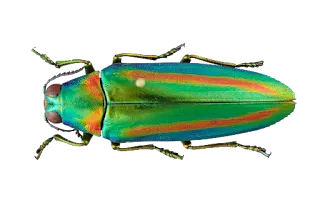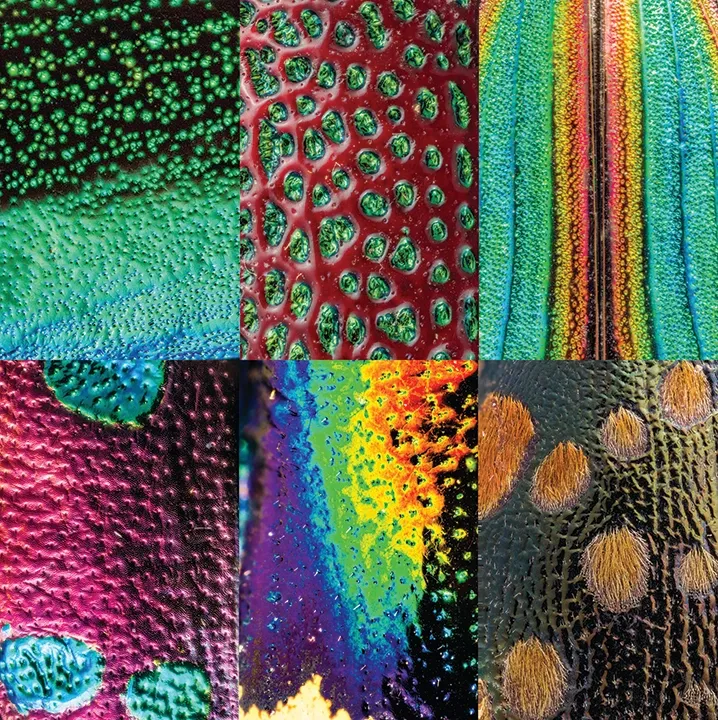Creationism in Crisis
Jewel Beetles Evolved by Gene Duplication
Jewel Beetles Evolved by Gene Duplication
Jewel Beetle, Chrysochroa raja
Jewel beetles evolve to see new colors by duplicating their genes | University of Minnesota
The beautiful Jewel beetle is about as devastating to Creationism as it would be if Michael J Behe announced that he was a secret evolutionary biologist all along, taking part in an elaborate experiment to test how gullible the average American fundamentalist is.
Recent research has shown that these beetles get their color from gene duplication. This is the process where a mistake in the duplication of DNA leads to genes being duplicated, creating a second, spare, copy. This copy is then free to mutate without any loss of function because the original is still functioning, creating new genetic information by mutation.
This is a problem for Creationists for two reasons:
- It refutes the claim that no new information can arise in a genome without the aid of magic because the amount of information in the Universe is fixed. This is based on some confused or deliberately misrepresented version of Shannon Information theory which equates information to energy and so makes it subject to the same laws of thermodynamics as energy. This is, of course nonsense, but makes those who used it sound as though they understand advanced physics.
- It refutes the claim that all mutations are detrimental so mutation can't be the source of beneficial alleles which natural selection can select for. It makes no difference to an organism if a 'spare' copy of a gene mutates in a way which would be detrimental if it was the only copy. However, if the mutation proves to be beneficial, it can be selected for by environmental selectors and so will quickly increase in the population gene pool. The genome of most organisms is littered with duplicated genes that have since mutated but are useless, as part of the junk DNA that all organisms carry.
The research, published open access in the journal Molecular Biology and Evolution was conducted by researchers from the University of Minnesota, Saint Paul, MN, USA and Louisiana State University, Baton Rouge, LA, USA, led by Camilla R Sharkey of the University of Minnesota.
Their research is explained in a University of Minnesota news release:
Jewel beetles are striking insects, easily recognized by their vivid colors and metallic sheen. Possessing large, well-developed eyes, jewel beetles use vision and color for a range of different behaviors, including finding mates and host plants.
Color vision in insects differs from our own. Special genes allow many insects to see ultraviolet (UV) light as well as blue and green. New research led by Camilla Sharkey, a postdoctoral associate at the Wardill Lab in the College of Biological Sciences, investigated the complex evolutionary history of jewel beetles’ vision. The research team included Jorge Blanco, formerly with the Wardill Lab and now at University of Maryland, Nathan Lord of Louisiana State University, and Trevor Wardill, assistant professor at CBS.
Previous research by Dr. Sharkey has shown that before the evolution of modern beetles, their ancestors lost the ability to see blue light around 300 million years ago. This may have been the result of the beetle ancestor becoming nocturnal or living in low-light conditions. Later, as beetles diversified, they evolved duplicates of the ancestral genes that allow them to see the UV and green spectrum. These duplicate genes could further evolve, making new parts of the color spectrum visible and allowing more complicated and diverse color signals to be seen.
Researchers wanted to know if the duplicate genes have evolved, allowing beetles to see colors that their ancestors could not. Since jewel beetles are difficult to keep in a lab, they copied the genes and inserted them into fruit flies, replacing their normal visual genes. Using electrophysiology, they tested the color sensitivity each gene produced in the flies. They then looked for genetic changes that might underlie the shifts in color sensitivity using 3D protein modeling.
The study found that:All jewel beetle species studied so far have the four differing gene types that were isolated in the research, suggesting that all jewel beetles probably have complex color sensitivity.
- Jewel beetles have evolved additional blue and orange sensitivity by duplicating and evolving their UV and green visual genes.
- This enables complex tetra-chromatic color sensitivity to UV, blue, green and orange wavelengths of light, similar to the color sensitivity of colorful birds.
- Newly evolved genetic changes related to color detection were not found to shift sensitivities as predicted when visual genes were modified and retested.
According to Sharkey,
the next step is to determine if specific types of color vision can be predicted from genes and how color vision is used by insects to better manage pest and pollinator insects, thus improving crop production.
Researchers also hope to understand the molecular basis of jewel beetle color sensitivity, which would provide a basis for predicting insect color sensitivity from the gene sequence.
 Copyright: © 2023 The authors.
Copyright: © 2023 The authors.Published by Oxford University Press on behalf of Society for Molecular Biology and Evolution. Open access. (CC BY 4.0)
AbstractSo there we have it: gene duplication followed by mutation and selection to give new genetic information and extending the beetles' ability to see a wider range of color and all explained by reference to the process of evolution.
The evolutionary history of visual genes in Coleoptera differs from other well-studied insect orders, such as Lepidoptera and Diptera, as beetles have lost the widely conserved short-wavelength (SW) insect opsin gene that typically underpins sensitivity to blue light (∼440 nm). Duplications of the ancestral ultraviolet (UV) and long-wavelength (LW) opsins have occurred in many beetle lineages and have been proposed as an evolutionary route for expanded spectral sensitivity. The jewel beetles (Buprestidae) are a highly ecologically diverse and colorful family of beetles that use color cues for mate and host detection. In addition, there is evidence that buprestids have complex spectral sensitivity with up to five photoreceptor classes. Previous work suggested that opsin duplication and subfunctionalization of the two ancestral buprestid opsins, UV and LW, has expanded sensitivity to different regions of the light spectrum, but this has not yet been tested. We show that both duplications are likely unique to Buprestidae or the wider superfamily of Buprestoidea. To directly test photopigment sensitivity, we expressed buprestid opsins from two Chrysochroa species in Drosophila melanogaster and functionally characterized each photopigment type as UV- (356–357 nm), blue- (431–442 nm), green- (507–509 nm), and orange-sensitive (572–584 nm). As these novel opsin duplicates result in significantly shifted spectral sensitivities from the ancestral copies, we explored spectral tuning at four candidate sites using site-directed mutagenesis. This is the first study to directly test opsin spectral tuning mechanisms in the diverse and specious beetles.
Camilla R Sharkey, Jorge Blanco, Nathan P Lord, Trevor J Wardill
Jewel Beetle Opsin Duplication and Divergence Is the Mechanism for Diverse Spectral Sensitivities
Molecular Biology and Evolution, 40(2) 2023, msad023, DOI: 10.1093/molbev/msad0
Copyright: © 2023 The authors.
Published by Oxford University Press on behalf of Society for Molecular Biology and Evolution. Open access
Reprinted under a Creative Commons Attribution 4.0 International license (CC BY 4.0)
As I said at the start, it doesn't get much worse than this for Creationists, so extra effort will be needed to ignore it.



No comments:
Post a Comment
Obscene, threatening or obnoxious messages, preaching, abuse and spam will be removed, as will anything by known Internet trolls and stalkers, by known sock-puppet accounts and anything not connected with the post,
A claim made without evidence can be dismissed without evidence. Remember: your opinion is not an established fact unless corroborated.